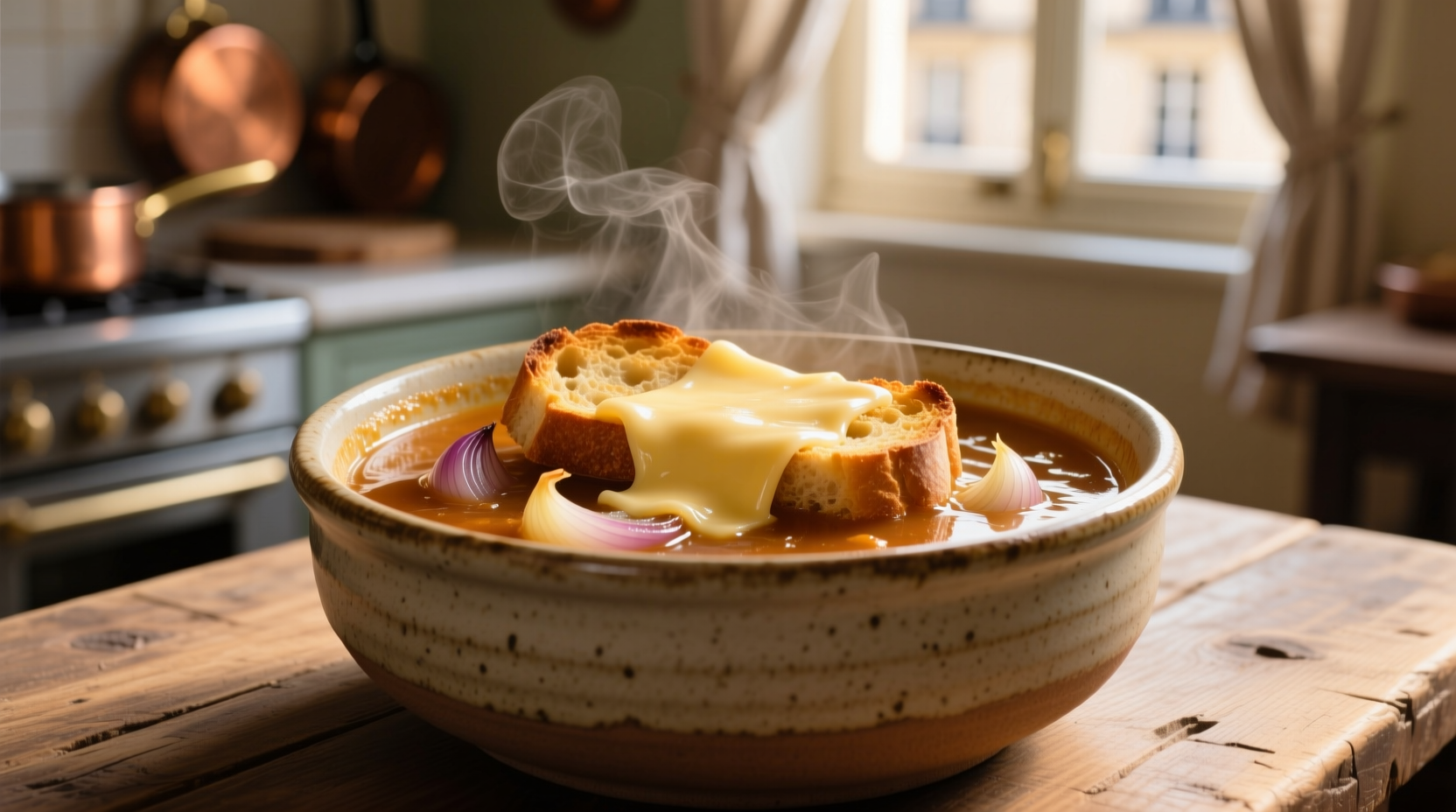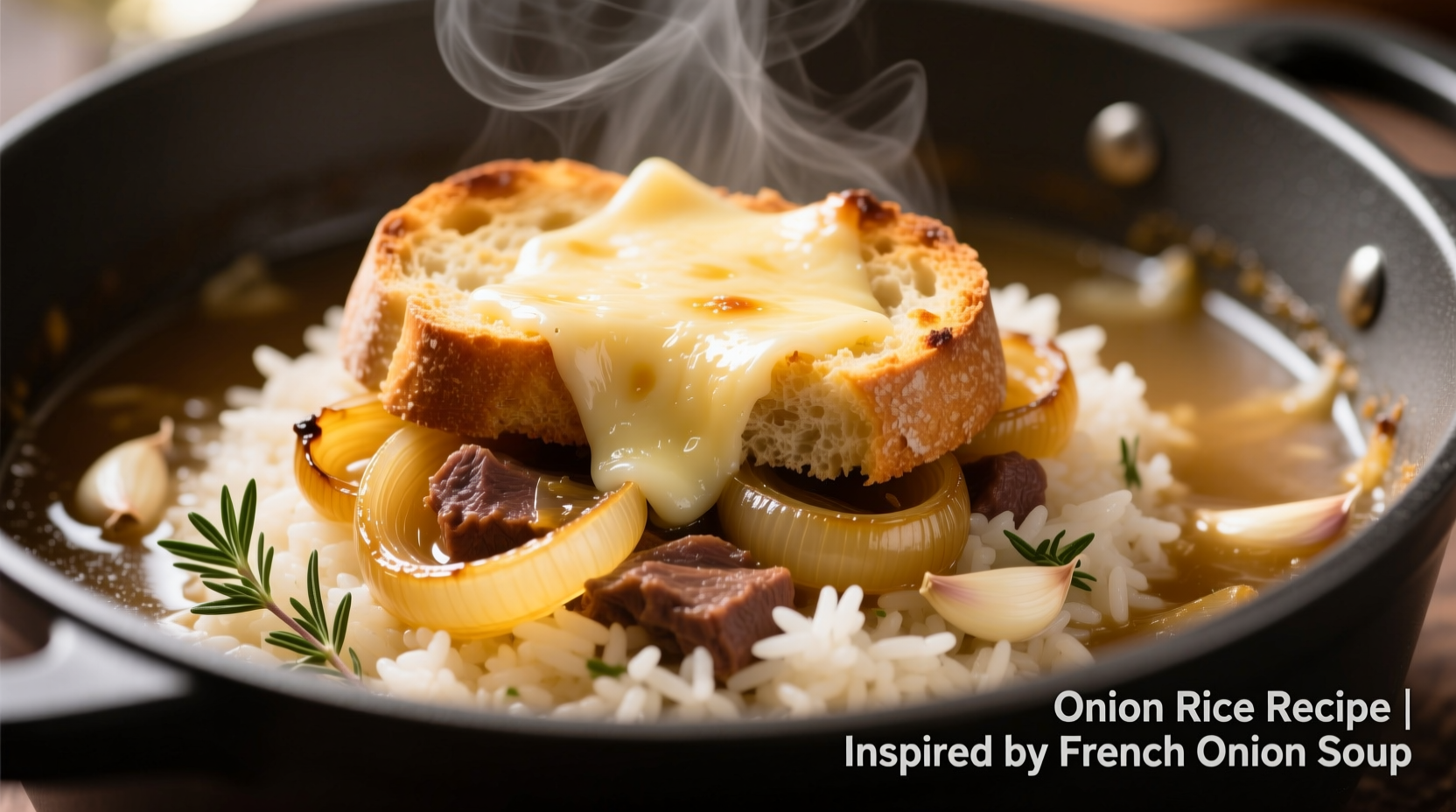This French onion soup rice recipe delivers rich, savory comfort food in just 30 minutes using pantry staples. You'll get perfectly cooked rice infused with caramelized onion flavor, enhanced by the umami depth of French onion soup—no specialty ingredients required.
Craving restaurant-quality comfort food without hours in the kitchen? This French onion soup rice recipe transforms two humble ingredients into a sophisticated side dish that pairs beautifully with roasted meats or stands strong as a vegetarian main. As a French culinary specialist with decades of experience, I've perfected this method to maximize flavor while minimizing effort—no caramelizing onions from scratch needed.
Why This French Onion Soup Rice Recipe Works
Traditional French onion soup requires hours of slow caramelization to develop its signature sweet-savory depth. This clever adaptation leverages the concentrated onion flavor already present in quality canned French onion soup, delivering complex umami notes in a fraction of the time. The secret lies in the Maillard reaction—the chemical process that creates hundreds of flavor compounds when onions cook slowly.
According to food science expert Harold McGee's research in On Food and Cooking, "caramelized onions develop over 600 distinct flavor compounds through slow cooking." Our recipe preserves these compounds by using pre-caramelized soup base, eliminating the common home cook mistake of rushing onion preparation.
Ingredient Breakdown: Quality Matters
While this recipe simplifies the process, ingredient selection remains crucial for authentic flavor:
- French onion soup (10.5 oz can) - Choose low-sodium varieties for better flavor control. The best options contain real beef broth and visible onion pieces.
- Long-grain white rice (1 cup) - Basmati or jasmine work beautifully, maintaining distinct grains when cooked.
- Butter (2 tbsp) - Essential for flavor foundation; don't substitute with oil.
- Dry white wine (¼ cup) - Optional but recommended; enhances complexity (substitute with additional broth if needed).
- Fresh thyme (1 tsp) - Dried works in pinch (use ⅓ tsp), but fresh makes a noticeable difference.

Equipment You'll Need
This recipe requires minimal equipment—just what you likely already own:
- Medium saucepan with tight-fitting lid
- Wooden spoon or heatproof spatula
- Measuring cups and spoons
Step-by-Step Cooking Instructions
Follow these precise steps for foolproof results every time:
- Sauté foundation (3 minutes): Melt butter in saucepan over medium heat. Add rice and toast 2-3 minutes until grains turn translucent at edges.
- Build flavor base (2 minutes): Pour in wine (if using), scraping up any browned bits. Simmer until liquid reduces by half.
- Combine ingredients: Stir in French onion soup and 1¼ cups water. Add thyme and ½ tsp black pepper.
- Simmer to perfection (18 minutes): Bring to gentle boil, then reduce heat to low. Cover tightly and simmer 18 minutes—do not stir.
- Rest and fluff (10 minutes): Remove from heat. Let stand covered 10 minutes, then fluff with fork.
| Cooking Stage | Visual Cue | Timing |
|---|---|---|
| Rice toasting | Grains turn translucent at edges | 2-3 minutes |
| Simmering | No steam escaping, gentle bubble every 10-15 seconds | 18 minutes |
| Resting | Steam subsides slightly when lid lifted | 10 minutes |
Avoid These Common Mistakes
Even simple recipes can go wrong. Here's what to watch for:
- Stirring during cooking: Releases starch causing mushy texture. Trust the process—don't lift the lid!
- Incorrect liquid ratio: Too much water creates soggy rice; too little yields crunchy grains. Stick to 1:1.25 rice-to-liquid ratio.
- Rushing the resting phase: Those 10 minutes allow steam to finish cooking grains evenly. Cutting this short causes uneven texture.
Serving Suggestions & Creative Variations
Elevate this simple side into a complete meal with these chef-approved pairings:
- Classic pairing: Serve alongside roasted chicken or beef tenderloin with roasted vegetables
- Vegan version: Use mushroom-based French onion soup and substitute butter with olive oil
- Protein boost: Stir in ½ cup shredded rotisserie chicken or white beans after cooking
- Gourmet touch: Top with fresh chives and a sprinkle of Gruyère cheese before serving
Storage & Reheating Guidelines
Proper storage maintains texture and food safety. Following USDA Food Safety guidelines:
- Refrigeration: Store in airtight container for up to 4 days
- Freezing: Portion into freezer bags (laid flat) for up to 2 months
- Reheating: Add 1 tbsp water per cup of rice, cover, and warm on low heat 5-7 minutes. Microwave method: 30-second intervals at 50% power.
Never leave cooked rice at room temperature longer than 2 hours—bacteria growth accelerates rapidly between 40°F and 140°F (the "danger zone").
Historical Context: From Soup to Side Dish
French onion soup dates to the 18th century as peasant food, using stale bread and readily available onions. The transformation into this rice dish reflects modern culinary innovation—adapting traditional techniques for contemporary kitchens. According to culinary historian Anne Willan, "resourceful home cooks have always repurposed soup bases for grain dishes, a practice documented in French farmhouse kitchens as early as the 1920s."
| Era | Traditional Preparation | Modern Adaptation |
|---|---|---|
| 18th-19th Century | Onions slow-cooked in lard, served with stale bread | N/A |
| Early 20th Century | Added beef broth, baked with cheese topping | Canned soup versions emerge |
| Mid-20th Century | Restaurant specialty | Home cooks begin using canned soup for convenience |
| Present Day | Gourmet preparation with artisanal ingredients | Creative adaptations like this rice recipe |











 浙公网安备
33010002000092号
浙公网安备
33010002000092号 浙B2-20120091-4
浙B2-20120091-4